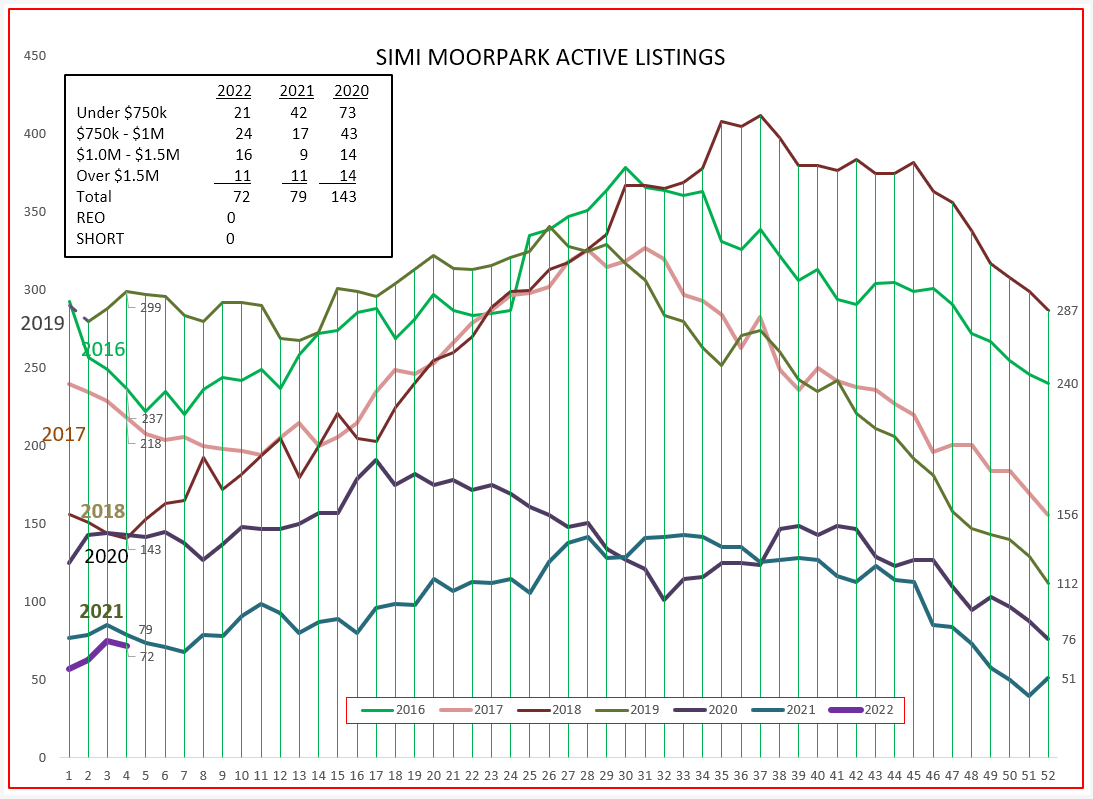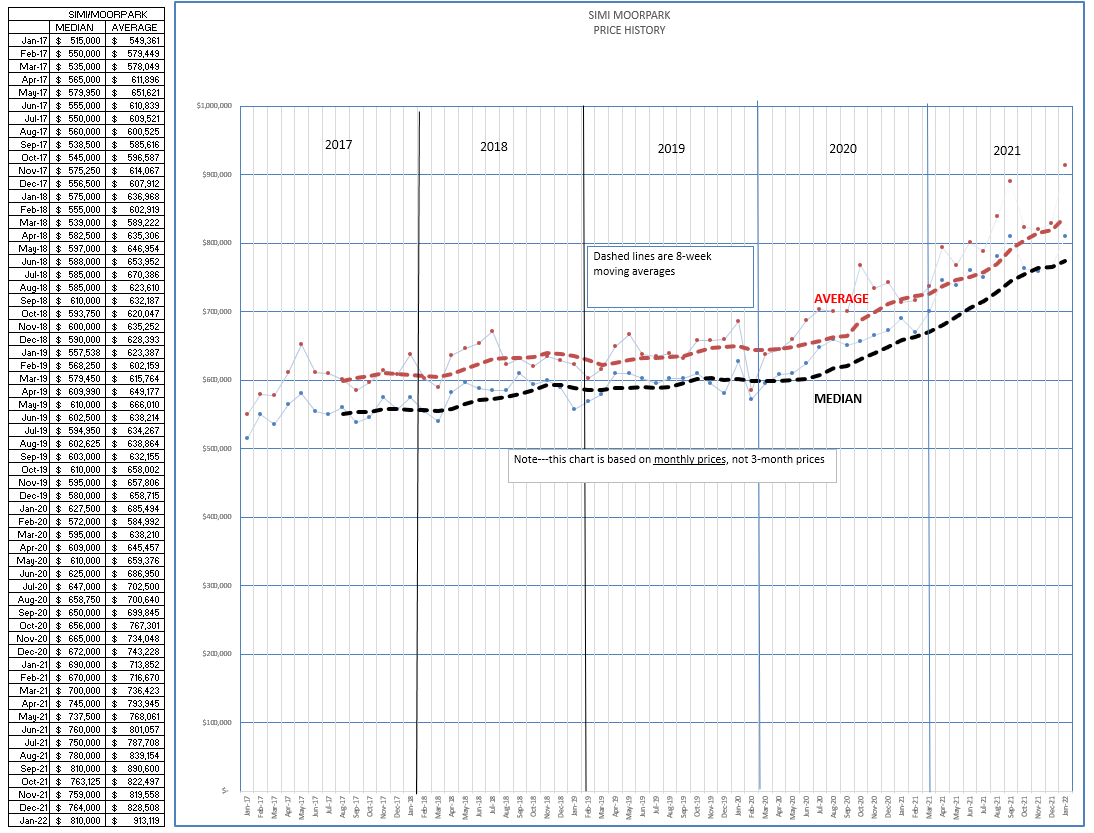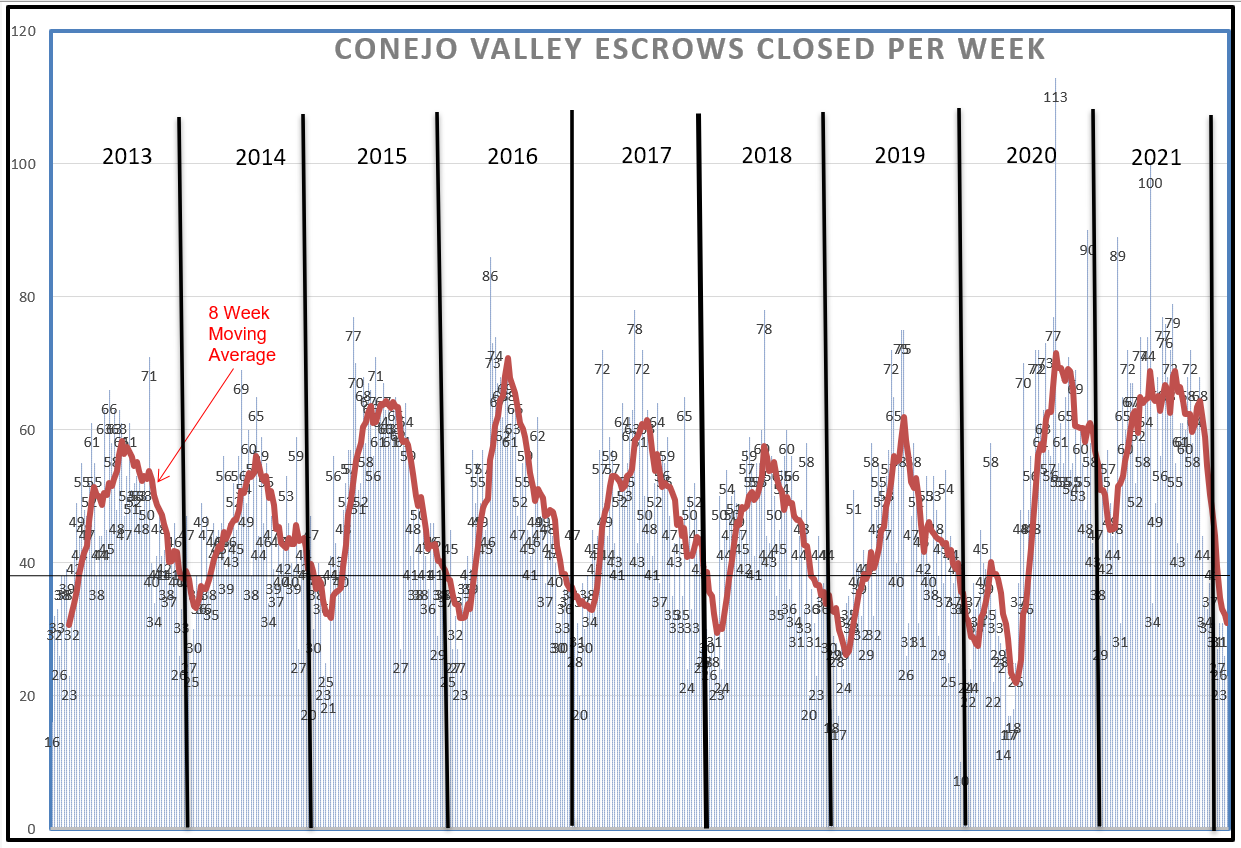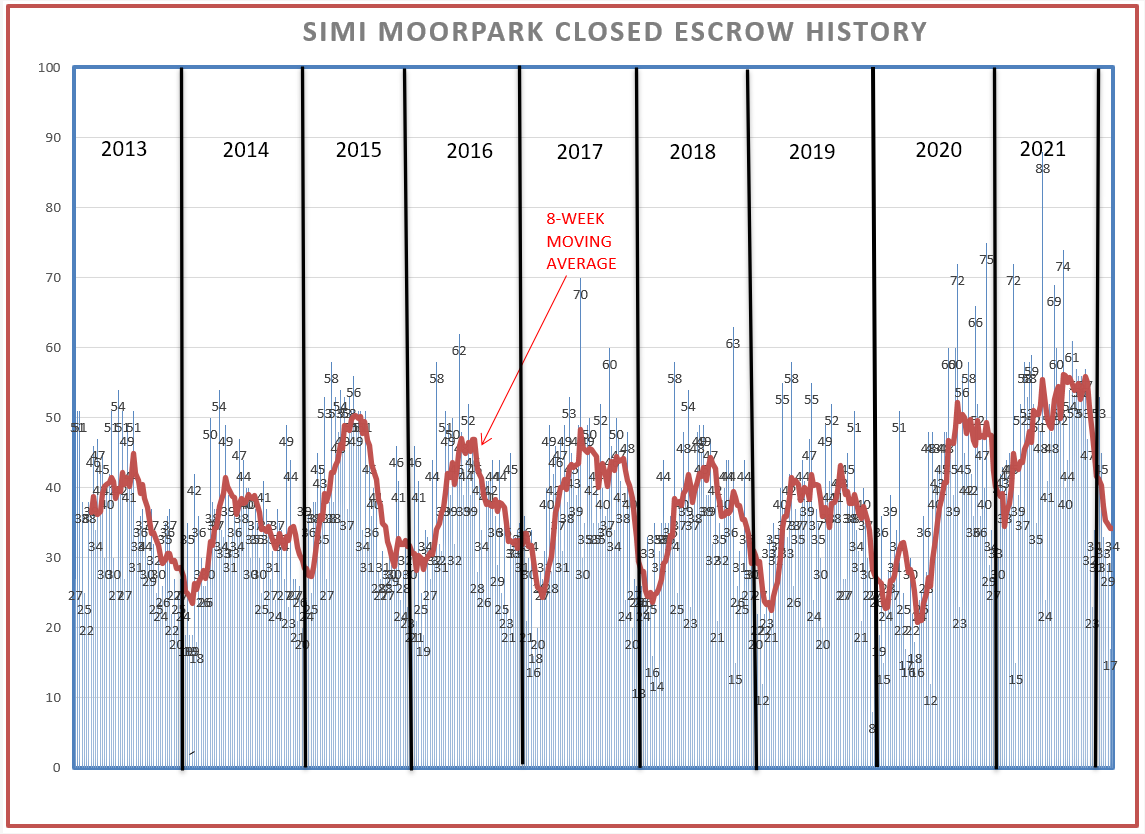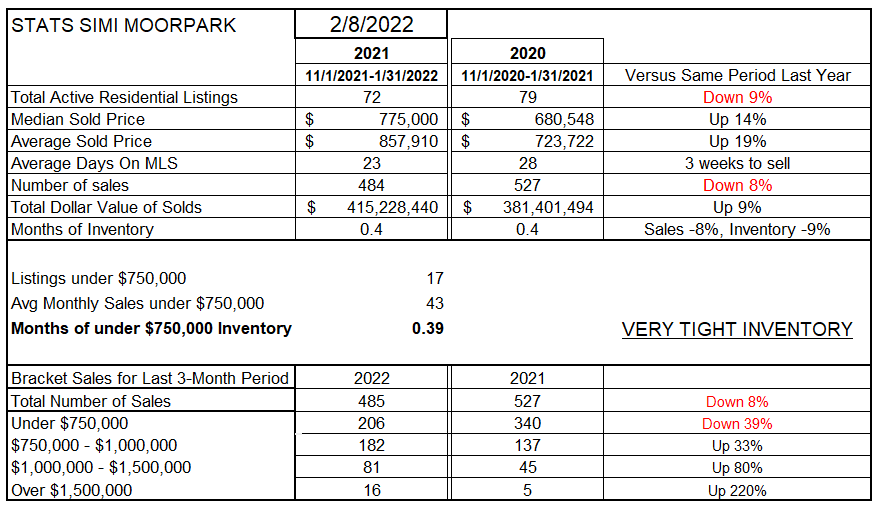Back to normal. After two years of covid, that is everyone’s wish.
Today the news is discussing the end of mask requirements. And the downturn of the omicron spike. Also about interest rates increasing to battle inflation pressures. Things are good. The unemployment rate is stable at 4%. The minimum wage in Los Angeles is going to $16 per hour, while fast food restaurants are currently offering $17 to workers they are trying to hire. The news is full of stories about the economy, where it has been and where it is going.
In this blog we are only concerned about that portion of the economy that exists in our valleys, the housing economy.
Our problem has been inventory, a lack of inventory that has created bidding wars and seen home prices skyrocket. How is inventory starting off the new year?
INVENTORY—No relief here. We are starting off the year with lower inventory since 2004, since I started recording inventory numbers. Prices were rising strongly in 2004, 2005, and 2006. The beginning January inventory in those years was 290, 393, and 652. We began this year with 92. The box within the chart shows the inventory level Feb 1 in 2022, 2021, and 2020. We cannot look to inventory (supply) to change the pressure on prices.
For Simi Valley and Moorpark, the inventory is even lower. The inventory is spread pretty equally among the four price segments I have been following. The inventory remains miniscule.
PRICES—how have prices changed over the past two years. (Two years, not one) January 2020 median prices were approximately $820,000, compared to January 2022 median prices of $1,000,000. A two year median price increase of $180,000, or 22%.
January 2020 average prices were approximately $950,000, compared to January 2022 average prices of $1,200,000. A two year average price increase of $250,000, or 21%.
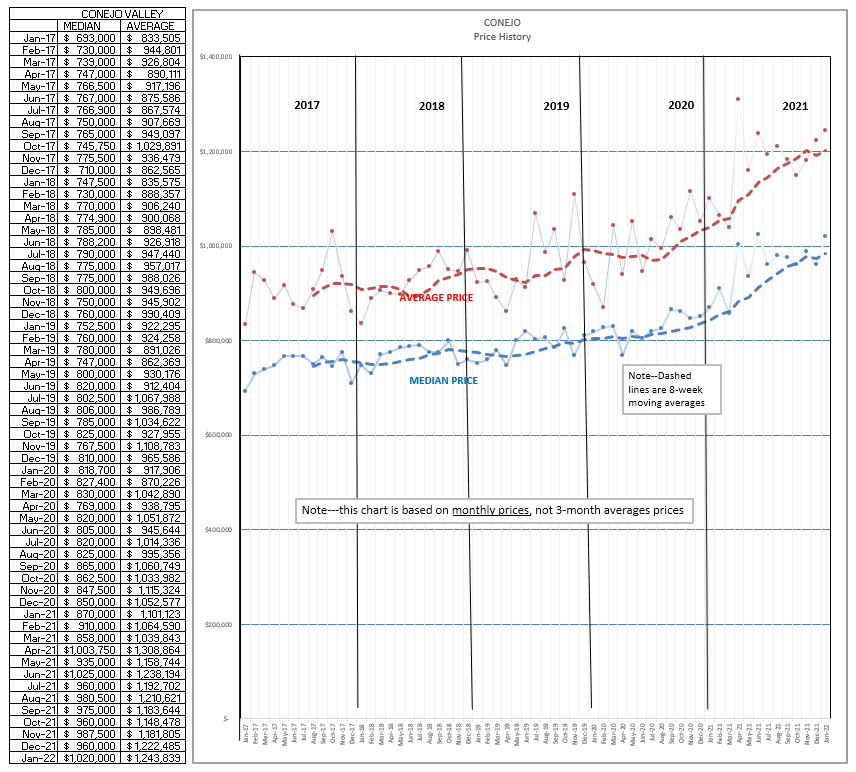 In Simi Valley and Moorpark, January 2020 median prices were approximately $600,000, compared to January 2022 median prices of $800,000. A two year increase of $200,000, or 33%. Simi/Moorpark begin their inventory shortage earlier than Conejo, probably due to their relatively better affordability.
In Simi Valley and Moorpark, January 2020 median prices were approximately $600,000, compared to January 2022 median prices of $800,000. A two year increase of $200,000, or 33%. Simi/Moorpark begin their inventory shortage earlier than Conejo, probably due to their relatively better affordability.
January 2020 average prices were approximately $650,000, compared to January 2022 average prices of $850,000. A two year average price increase of $200,000, or 31%. Looking at the appreciation percentage, the percentage return was higher when initial prices were lower.
DEMAND—To judge how demand is going, I am gong to return to my older charts that compare how closings have progressed over the year, comparing one year after another. In a normal year, we see closed escrows begin the year by receding, since escrows occur a month after contracts are agreed to. The end-of-year holidays result in a very low number of contracts. The chart below shows the 8-week moving average in January receding to approximately 30 average weekly sales, and then climbing in February.
This experience occurred in every one of the years since 2013 except for one, January of 2021. Covid caused inventory to be extremely low. Uncertainty caused owners to want to stay put until the pandemic waned. Covid also precipitated a desire to move to the suburbs. Covid caused a desire to own rather than rent. All this extra demand soaked up our low inventory, Price was not a major stumbling block thanks to historically low interest rates. Multiple offers and prices over list became the standard. Whatever was listed, sold. Demand became artificially high. This feeling caused store shelves to be void of toilet tissue, and the MLS shelf became void of available inventory. This is not a normal situation. This is sometimes called panic buying. But we are done with that. We are returning to normal. Sales levels for January have returned to normal historical levels.
Simi/Moorpark has seen the same effect, with prices dropping to a lower level, albeit higher than the historical January inventory level. I suggest this is a result of the relative better affordability of homes compared to Conejo, and the even lower inventory level in Simi/Moorpark. It is the same factor that caused Simi/Moorpark prices to increase at a higher percentage than Conejo, although the increase in prices has been phenomenal in both valleys.
Let’s close with a look at the statistical charts. These numbers may look a little different than the previously numbers because they relate the last three months we experienced versus those same three months a year ago.
During the year, Median prices increased 16% while Average prices increased 13%. The inventory is the same as previously discussed, down 24% from the inventory a year ago. The number of sales in this period compared to a year ago declined 19%. Perhaps the most telling numbers in the chart are near the bottom. Due somewhat to prices moving up, sales under $1,000,000 are down significantly from a year ago, while sales over $1,000,000 are up significantly. But that does not explain the overall number,. Total sales remain down 19%.
For Simi/Moorpark, inventory is down 9%. The 3-month median of prices is up 14% compared to last year, while average prices are up 19%, over one year. Sales are down only 8%. Conejo sales were down 19%. Simi/Moorpark sales remain relatively stronger. Sales of homes below $750,000 are down compared to last year, while sales of homes priced above $750,000 have increased versus last year. But Simi/Moorpark does not have the percentage of higher priced sales that Conejo has, and I believe sales are slowing down more than the graph above may show, due to a lack of inventory.
So what is happening? All good things must come to an end. In this case, that is good news. We are not in a bubble, but if prices and sales were to continue at the pace they did the past two years, the chances of a bubble would be greater. Mortgage rates have increased, and the forthcoming Fed interest rates hikes will also boost mortgage rates. Will we continue to see prices increasing by double digits? That is doubtful, and at the same time that is good. Stability is needed. Homes are not bought and sold like stocks. They are fabulous assets, and you can live in them, enjoy them. But they are not day-traded. Higher mortgage rates will also influence seller decisions. Sellers may be able to find a better house, but it will be difficult for them to find a better mortgage. (a quote from Joel Singer)
My advice—it is time for the professionals to shine. It will be more difficult to sell a home. You may actually be seeing a sign in the lawn before the house is sold. Professionals understand the market, they understand the factors affecting price. There will still be a market, because of the many reasons that people decide to sell a home, and the many reasons that people decide to buy a home. Rents will remain extremely high, making the vision of locking in your rent for 30 years by buying a home with a fixed 30-year mortgage very attractive. In addition, everyone has seen how attractive it is to own a home that appreciates in value.
Hone the new skills Covid has forced you to learn. Become more expert at pricing, digital advertising, market knowledge, and virtual tours. Buyers will still want to physically view a home before writing an offer, but their first visit will be via a virtual tour. First time buyers and veterans will finally have a chance to compete with all cash buyers, who will soon look for different areas to invest in for higher immediate returns.
And most of all, stay safe. Stay smart. This covid thing may not be completely over, even though everyone wants it to be. I believe we are nearing the end, but I am much more an economist than a doctor. Prayers, fingers crossed, vaccines, do what works for you. We all want the same thing. Normal. And the market is heading there too.
Chuck

